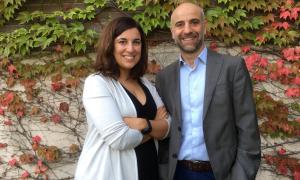A study unravels new stem cell transplant factors that might lead to HIV eradication in the body

The article, co-led by IrsiCaixa (Barcelona) and Gregorio Marañón Hospital (Madrid), shows for the first time that stem cell source, time to achieve full replacement of recipient cells with donor cells and graft-versus-host reactivity might contribute to HIV eradication. These findings could serve for the design of new HIV cure strategies.
Antiretroviral treatment is unable to cure HIV infection due to viral reservoir, consisting of HIV-infected cells that remain latent and cannot be detected and destroyed by the immune system. Now, researchers from the IrsiCaixa AIDS Research Institute (Barcelona, Spain) and the Gregorio Marañón Hospital (Madrid, Spain), point out certain mechanisms associated with stem cell transplant that might contribute to HIV reservoir eradication, after 5 patients who received a stem cell transplant have undetectable HIV reservoir and HIV antibodies are no longer found in one of them. These findings could serve for the design of less-invasive HIV cure strategies, since stem cell transplant is exclusively recommended in life-threatening haematological conditions. The study, published in the journal Annals of Internal Medicine, has been performed by the IciStem consortium, which was constituted in 2014 with funding from The Foundation for AIDS Research, amfAR.
The study was built upon the case of The Berlin Patient: Timothy Brown, a HIV-positive man who received a stem cell transplant to treat leukaemia. The donor had a mutation called CCR5 Delta 32 that made his blood cells nearly immune to HIV because it averts the virus entry. Brown stopped taking HIV medication and today, 11 years later, the virus is no longer found in his blood. He is thought to be the only individual cured of HIV.
Since then, scientists investigate the mechanisms of HIV eradication associated with stem cell transplant. The IciStem Consortium has built a unique worldwide cohort of HIV infection individuals that underwent through a transplant to cure their haematological disease, with the ultimate goal of designing new cure strategies. “Our hypothesis was that, in addition to the CCR5 Delta 32 mutation, other transplant-associated mechanisms had a strong influence on HIV eradication,” says Maria Salgado, PhD, researcher from IrsiCaixa and co-first author of the article.
The study included 6 participants who had survived for at least 2 years after receiving the transplant. All donors lack the CCR5 Delta 32 mutation on their blood cells. “We selected these cases because we wanted to focus on other potential causes that might contribute to eliminate the virus”, explains Mi Kwon, MD from the Gregorio Marañón Hospital and co-first author of the paper.
Undetectable reservoir in blood and tissues
After the transplant, all the participants maintained antiretroviral treatment, no longer had immunosuppression and achieved remission of their haematological disease. Five of them had undetectable reservoir in blood and all analysed tissues. This is relevant because these parameters are always detectable in HIV-infected people, despite effective antiretroviral treatments. Moreover, in one of the participants, viral antibodies fully disappeared 7 years post-transplant. According to Salgado, “this could be a prove that HIV is no longer in his blood, but this only can be confirmed if we stop antiretroviral treatment and we don’t see evidence of viral rebound.”
The only participant with a detectable HIV reservoir received a cord blood transplant –the other cases had a bone marrow transplant– and showed delayed achievement of complete replacement of his cells by donor’s cells (18 months). “This process can take from 1-2 months to over a year and we have observed that the shorter, the more effective the reduction of the reservoir is”, explains Kwon.
Another point of interest is graft-versus-host disease, which occurs when cells from the donor attack the recipient's cells, and that was not developed by the only participant with detectable reservoir. “This suggests that if we manage to control it so that it is not fatal –says Jose Luis Diez-Martin, haematologist from the Gregorio Marañón Hospital and co-leader of the study–, not just tumor cells from the recipient are destroyed, but also other cells including those of the viral reservoir.”
Looking for safe and alternative strategies
These findings could serve for the design of less-complex and invasive HIV cure strategies, since stem cell transplant presents a high mortality risk and is only recommended in life-threatening haematological conditions. “Our goal is to elucidate the factors that help to eradicate the virus after transplant, and then mimic them with safer alternative strategies than this intervention,” concludes Javier Martínez-Picado, ICREA research professor at IrsiCaixa and co-leader of the article. Martínez-Picado is also co-director of the IciStem consortium together with Annemarie Wensing, clinical virologist from the University Medical Center Utrecht (Netherlands).
The next step will be performing a clinical trial that combines new immunotherapies with medically supervised removal of antiretroviral drugs in some of these patients, in order to know if there is viral rebound and confirm whether the virus has been eradicated from their bodies.